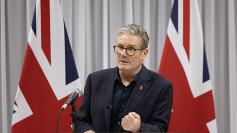The eurozone saw further contraction in its service sector in October, while manufacturing continued to slow down. Data released on November 6 confirmed that the final value of the Hamburg Commercial Bank's Composite Purchasing Managers' Index (HCOB PMI) for October was 46.5, down from 47.2 in September. This acceleration in the contraction of private sector activity in the eurozone suggests that there are downward risks to GDP growth.
The HCOB PMI, compiled jointly by Standard & Poor's, is a crucial indicator of overall economic health, and a value below 50 percent indicates contraction from the previous month. The October HCOB PMI has been below the 50 percent threshold for five consecutive months, marking the lowest point since November 2020 and indicating the most severe economic contraction in nearly three years for the eurozone.
Looking more closely, the manufacturing PMI fell from 43.4 in September to 43.1 in October, slightly above the forecasted 43.0. Cyrus de la Rubia, Chief Economist at Hamburg Commercial Bank, noted that the eurozone's manufacturing sector has been in a slump for the past two years, with the new orders index stagnant and deeply negative.
The index for new orders declined for the 18th consecutive month, slipping from 39.2 percent to 39.0 percent, indicating a drop in manufacturing demand. Additionally, factories' demand for raw materials was low, with the purchasing quantity index hitting a record low. In response to weak demand, factories have been cutting prices for six months straight, but this has done little to boost demand.
The service sector PMI dropped from 48.7 percent in September to 47.8 percent, indicating continued contraction in October. The sector's poor performance was attributed to a lack of job positions. De la Rubia stated that since July, the eurozone has faced issues with job positions not matching demand.
The new business index, which measures demand, fell from 46.4 percent to 45.6 percent, with consumers heavily impacted by rising prices and increased borrowing costs, leading to continued weak demand and significant contraction in service sector economic activity across European countries. Germany, the largest economy, saw its service sector contract again in October, while Italy's service sector has been shrinking for three months, and France's service sector also showed signs of contraction.
Spain's service sector, however, bucked the trend, showing a slight increase in growth since September. The country has seen a recent rise in job demand, with the service sector growing for two consecutive months, rising from 50.5 percent in September to 51.1 percent in October, with service providers in Spain remaining optimistic about future prospects. Nevertheless, due to the continued weakness in manufacturing, the overall economic outlook for the country remains pessimistic.
Overall, the data indicates that the eurozone is experiencing economic contraction and a decline in inflation levels due to interest rate hikes by the European Central Bank. Since July last year, the ECB has raised rates ten times, totaling a 450 basis point increase.
Data at the end of October showed that eurozone inflation in October dropped to its lowest level in over two years. According to the European Union's statistics office, the CPI increased by 2.9 percent year-on-year in October, the lowest rate since July 2021, and below September's 4.3 percent. At the same time, the eurozone's GDP contracted by 0.1 percent quarter-on-quarter, facing the risk of recession.
Geopolitical uncertainty and the interest rate hike cycle are expected to continue affecting the eurozone's economic activity for several months. De la Rubia from Hamburg Commercial Bank believes that the eurozone's GDP is likely to continue contracting in the fourth quarter.
According to Reuters, economists generally believe that the geopolitical outlook, price levels, and GDP data indicate that the eurozone economy has begun to enter a mild recession. Bert Colijn, an economist at ING Bank, thinks that the current economic environment is indeed deteriorating, but it is still far from a severe recession.
For the European Central Bank, although the economy is on a downward trend and inflation is slowing after ten consecutive rate hikes, reaching the inflation target of 2 percent remains a long and difficult journey, possibly not achievable until 2025.






